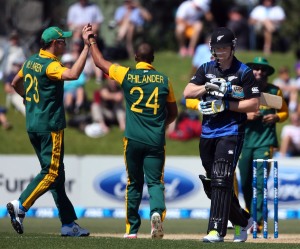ESPNcricinfo: Gregory Bino
Over the last few years, South Africa have mastered the art of batting in a bubble in Tests, distracted by nothing in the inexorable progress towards their goal. In Mount Maunganui, they adapted that method to one-day cricket, with AB de Villiers and JP Duminy pacing the chase to perfection. Their calmness against tight bowling, predatory fielding, and an asking rate inflated by a boundary drought, was in contrast to the helter-skelter approach that had crippled New Zealand to a below-par total on a slow surface.
Duminy pacing the chase to perfection. Their calmness against tight bowling, predatory fielding, and an asking rate inflated by a boundary drought, was in contrast to the helter-skelter approach that had crippled New Zealand to a below-par total on a slow surface.
The New Zealand innings – in their first ODI since January, and their first international since July, at a venue they had never played at – was a blur of boundaries and impatient partnerships cut down by disciplined bowling. Wickets fell in clutches, they were nine down in the 35th over before Luke Ronchi led a record last-wicket stand to frustrate the visitors. The pillars of South Africa’s line-up, however, batted with tunnel vision. Hashim Amla, de Villiers and Duminy were unperturbed by the asking rate rising from 4.62 to over a run a ball. The contest was never as close as the equation seemed to indicate, and they eventually won with 11 balls to spare.
The earliest start to a New Zealand summer ever began in bright sunshine. Spectators lounged on the grass banks of Bay Oval, another idyllic New Zealand venue, as the home team welcomed Daniel Vettori back into the side for the first time since July 2013. The absences of Kane Williamson and Ross Taylor because of injury left the batting brittle, though, and once the relentless Vernon Philander punched the first holes, South Africa did not lose grip on the innings until they had knocked nine batsmen down.
The pitch was slow and not conducive to shot-making to take advantage of a quick outfield. But it did not offer much deviation in the air or off the surface either. While Dale Steyn aimed full and fast, Philander clustered his seemingly gentler deliveries around a good length, nipping them in and out to keep New Zealand’s openers in perpetual uncertainty.
The experiment of opening with James Neesham produced 21 runs before the left-hand batsman prodded at one from Philander that seamed away. Quinton de Kock claimed the first of six dismissals. Philander then moved the ball in the other direction – away from the right-hander – to draw the edge from Martin Guptill, who had attempted a booming drive to improve his strike rate of 17.
From 35 for 2 in the tenth over, New Zealand counterattacked, but it was brief. Dean Brownlie, trialed at No.3, pulled a free-hit from Morne Morkel for six and then clipped two successive fours to the midwicket boundary. Brendon McCullum spoiled Philander’s figures of 5-1-7-2 by launching him over the straight and midwicket boundary for successive sixes in the last over of his first spell. New Zealand moved briskly to 68, but then they lost three wickets in eight balls for no runs.
South Africa successfully reviewed Imran Tahir’s appeal for a caught behind against Brownlie – Snicko and common sense trumped the lack of hot spot – and Morkel took out McCullum and Corey Anderson off successive deliveries. Tom Latham had a 65-run partnership with Ronchi in 11 overs, but once he was stumped another clutch of wickets followed and New Zealand were 156 for 9 with 92 balls to go.
After an edge off Morkel and a measured punch against Steyn had brought him boundaries, Ronchi moved into high gear against Ryan McLaren, driving and pulling for three fours in four balls. The frequent wickets made Ronchi temper his aggression, but when he had only Boult for company he turned it on again. Ronchi had got to 50 off 57 balls and pushed his strike rate over 100 during a Philander over in which he collected boundaries through midwicket, point and straight down the ground.
Ronchi could have got to a maiden ODI century but, on 98, he refused a second run so he could retain the strike. It wasn’t to be, though, for he edged Steyn’s first delivery of the 46th over, leaving South Africa with 231 to chase.
Boult began the defence by swinging the ball at pace to find the edges of Quinton de Kock and Faf du Plessis. Rilee Rossouw, picked ahead of David Miller, was aggressive before nicking Corey Anderson to slip, leaving South Africa 73 for 3 in the 19th over. The spinners Vettori and Nathan McCullum were operating with economy and with the fielders began to dive and prevent boundaries and singles, New Zealand felt they were in with a shot. That feeling was heightened when Amla played on to Kyle Mills for 38 off 74 deliveries, with only one four.
The asking rate touched six for the first time in the 33rd over – 104 off 104 – and Vettori tipped it over soon after. No boundary had been struck since 16.4. And then, in the 37th over after the batting Powerplay was taken, de Villiers decided it was time. He drove Vettori through midwicket and lofted him down the ground for successive boundaries, as if to tell his opponents that he could have done this all along, but had waited because he chose to.
South Africa 236 for 4 (De Villiers 89*, Duminy 58*) beat New Zealand 230 (Ronchi 99, Tahir 2-37) by six wickets

